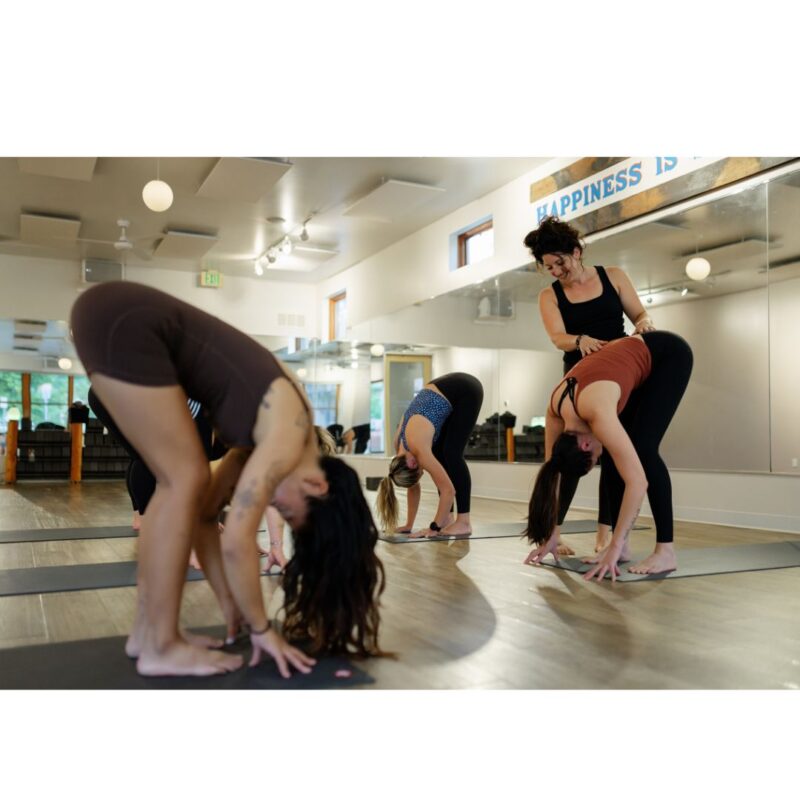
Yoga and Knee Pain: Your Do and Don’t Guide
Knee pain. It’s something many of us know all too well. Whether you’re an athlete pushing through an injury or a dedicated yogi just trying to stay active, knee discomfort can feel like a constant hindrance. I get it—trust me. As a 14-year-old track athlete I was told I had the knees of a “65-year-old due for a double knee replacement”… Yeah, talk about a wake-up call! But here’s the good news: yoga has been a total game-changer for me. It’s helped me manage joint pain, improve strength, and keep my body moving in ways I never thought possible.
Yoga is all about honoring what your body needs in the moment. Whether you’re recovering from an injury or you’ve been practicing for years, yoga can work wonders for your knees and your joints—if you know how to approach it with care.
Before we jump into our poses, here are three key tips to keep in mind:
- DO NOT overdo it—if something hurts, stop and back off. There’s no need to push through the pain, especially when it comes to joint health. Your body will thank you for listening.
- Give your knees time to recover—Don’t do these movements everyday. Rest is just as important as movement when it comes to healing and rebuilding muscle.
- Consult a professional if you’re experiencing persistent or extreme knee pain of unknown origins. A healthcare provider can help you get to the root of the issue and guide you toward the right treatments.
If you’ve been wondering how to ease knee pain or build strength without pushing yourself too hard, this guide is for you. We’ll dive into the best yoga poses for relieving knee pain, identify which poses to avoid, and share knee-strengthening exercises that will help you feel strong and supported as you move through your practice. With a little patience and a lot of mindfulness, you’ll be back on track—ready to take on your yoga mat and life, pain-free.
- Best Yoga Poses to Alleviate Knee Pain
It is essential to choose movements that strengthen the muscles surrounding the knee joint without overloading it. Yoga can be incredibly effective for joint health and mobility, but it’s important to take each pose slowly and intentionally.
- Chair Pose into Forward Fold (Utkatasana to Uttanasana): Utilize these poses to gently stretch the hamstrings and strengthen your quads. Beginning in Chair Pose, pay close attention to your knee alignment. Be sure that your knees do not extend past your toes to avoid added strain. Slowly dive into Forward Fold, only going as far as what is comfortable. Maintain a slight bend in your knees to reduce the stretch on your hamstrings. This pose will strengthen the muscles surrounding your knee joint, which is imperative for stability and support.
- Warrior 1 into Triangle into Revolved Triangle: This sequence will strengthen your legs, open your hips and give you an amazing stretch in your IT bands, all working towards stabilizing the knee joint. In Warrior 1, find a deep bend in your front knee, firing into the Quads and Inner Thighs. As you move into Triangle, be mindful not to overextend your legs. Stay aligned with your toes and keep a slight bend in the knee to protect the joint. While you open up in Revolved Triangle, breathe deeply into the IT band stretch, but don’t overdo it. If the stretch feels too intense, modify by placing your hand on a block.
- Warrior 2 to Skandasana: Moving between these two poses will promote balance and stretch the hips and groin. Most importantly, this movement is amazing for kneecap tracking. If you suffer from Patellar Tracking Disorder like me, this sequence will be an absolute game changer. Beginning in a deep, stable Warrior 2, slowly (like… VERY slowly) bend into the other knee as you sink into Skandasana. The key here is not depth, but awareness. If your side quads are not strong enough to support a slow descent into Skandasana it will be very beneficial to place your hands on blocks as you guide your knee into a deep bend. Move back and forth between these poses, all the while stay focused on the way your kneecap tracks across the movement. Like I said before, if you are feeling any pain, back off immediately. Recovery is a marathon, not a sprint.
- Bridge Pose (Setu Bandhasana): This pose fires deeply into your glutes while putting very little pressure on the knees, making it an amazing pose to work on your main balancing muscles. The trick here is to fire into your inner thighs. If you’re having trouble with this activation you can try placing a block between your legs and squeezing as you lift your hips higher. Working muscles that stabilize the knee joint is imperative to a well-rounded recovery.
- Lizard Pose (Utthan Pristhasana): This deep lunge helps open the hips and groin, areas that can often become tight and contribute to knee pain. While we have been avoiding allowing our knees to move past our toes so far, this pose will safely allow you to stretch into your full range of motion. Afterall, the knee going past the toes is a normal function of a healthy knee joint. Use this pose to test the waters for your mobility. If the stretch feels too deep, use a block to hold yourself up while you focus on moving your knee through its full range of motion.
- Poses to Avoid if You Have Knee Pain
While yoga can be incredibly beneficial for knee health, there are certain poses that may exacerbate knee pain, particularly if you are recovering from surgery or injury. It’s essential to practice caution and choose poses that do not put unnecessary strain on the knee.
- Child’s Pose or Frog Pose: These two poses can put excessive pressure on your interior ligaments if not modified properly. Further, adding weight to knees in such deep flexion can cause more pain. If you’re finding discomfort, try widening your knees to create a more supportive position, or use padding under your knees and shins. If the pain is too much, a seated forward fold will get the job done!
- Eagle Pose (Garudasana): This pose requires a tight leg bind, which can strain your knees if they are already sensitive or recovering from injury. Not to mention, this pose is not accessible for those with compromised knee and hip mobility. If you choose to practice it, do not force the wrap! You can easily modify this pose by placing your ankle on your knee in a figure four position before sinking deeply into the standing leg. Or simply drop the wrap altogether, opting for a normal Chair Pose with bound arms.
- Dancer Pose or Bow Pose (Natarajasana or Dhanurasana): These poses require careful attention to joint alignment, as they can easily push your knees into overextension, especially if you have bad joint health. If you’re determined to try them, prioritize alignment over depth. Keep your hips square and fight the urge to allow your knee to flare out to the side. It’s essential to focus on maintaining proper alignment in your joints before trying to deepen the pose. If you’re unsure, consider staying in a balanced quad stretch or take a supported backbend instead.
- Camel Pose (Ustrasana): While Camel Pose is great for opening the heart and improving back flexibility, it places massive undue stress on the knees. If you experience discomfort, consider placing a blanket under your knees or substitute with a gentler backbend, such as Cobra or Cat-Cow.
- Knee-Strengthening Exercises
To support your knee health and recovery, strengthening the muscles surrounding the knee joint is essential. These exercises target the quads, hamstrings, and glutes—building strength and stability that will free your range of motion and boost your confidence on the mat.
- Step Ups: Using a bench or block, step up with one leg and slowly lower yourself back down. This simple exercise strengthens the quadriceps and glutes, helping to stabilize the knee and prevent future injury.
- Straight Leg and Side Leg Raises: These two exercises are excellent for strengthening the hip and thigh muscles, which provide support to the knee. While lying on your back or side, raise one leg at a time, keeping the leg straight to avoid unnecessary stress on the knee joint.
- Bodyweight Squat: This classic exercise helps build strength in the quadriceps, hamstrings, and glutes. Focus on proper alignment by keeping your knees behind your toes and engaging your core. If your knees are sensitive, reduce the depth of the squat or try wall sits instead.
- Supported Pistol Squat: Using a chair or wall for support, perform a single-leg squat while pushing your leg in front of you. This exercise helps improve balance and strengthens the muscles around the knee. Focus on keeping the knee aligned with your toes and avoid locking the joint.
- ATG Lunges: This deep lunge is your chance to practice moving your knee through its full range of motion (yes that means allowing your knee to pass your toes!). To protect the joint, ensure your knee tracks in a straight line, avoiding any inward or outward twisting.
- Side Lunge: This exercise strengthens the inner and outer thighs, which are essential for stabilizing the knee and achieving more depth in Skandasana. Push your hips back and lower into the lunge, keeping your knee behind your toes for optimal alignment.
- Squat Side Walks/Monster Walks: Using a resistance band around your knees, find a deep squat and then take small steps from side to side. This movement strengthens the hip abductors, which play a key role in knee stability.
Conclusion
Whether you’re recovering from knee surgery, managing an injury, or simply looking for ways to maintain mobility and strength as you age, yoga can be an invaluable part of your recovery plan. By practicing with caution, modifying poses as needed, and incorporating knee-strengthening exercises, you can improve your knee health and maintain an active lifestyle. Listen to your body, and remember to consult a healthcare professional if you have any doubts or persistent pain. With consistency and care, you’ll be able to move with greater ease and confidence, both on and off the mat.
